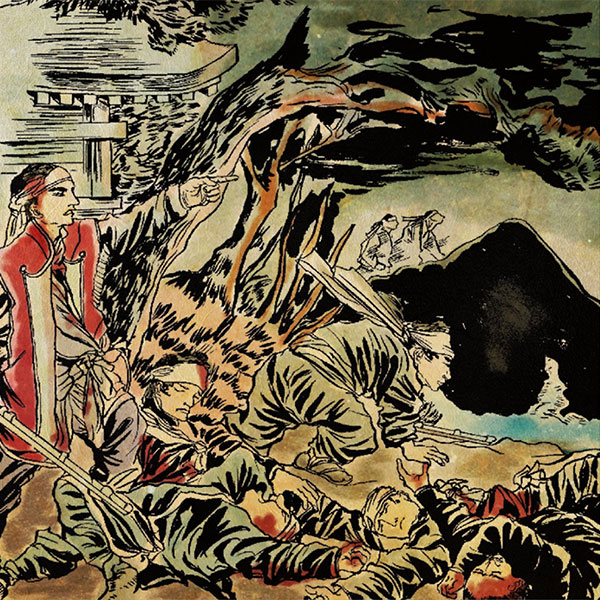- Nihonmatsu Domainsuffered from famine and population decline
- The Nihonmatsu Domain was a domain that ruled over Nihonmatsu City, Fukushima Prefecture. If you are a fan of the history of the end of the Edo period, you may have a strong image of this being the domain where the Battle of Nihonmatsu took place. The Nihonmatsu domain was established in the early Edo period after several families became feudal lords.

Nihonmatsu CastleNihonmatsu City, Fukushima Prefecture
- TOP
- Tohoku
- Fukushima Prefecture
- Nihonmatsu Castle
| Other name | Kasumigajo, Shirahata Castle |
|---|---|
| castle construction | not clear |
| address | 3-chome and 4-chome, Kakuuchi, Nihonmatsu City, Fukushima Prefecture |
Nihonmatsu Castle is one of Japan's top 100 castles. On July 26, 2007, Nihonmatsu Castle Ruins was designated as a national historic site.
- Access to Nihonmatsu Castle
- About 20 minutes walk from Nihonmatsu Station on the JR Tohoku Main Line.
HISTORYNihonmatsu Castle was the only site of battle in the Edo period after the Battle of Osaka.
Nihonmatsu Castle is a flat castle located in Nihonmatsu City, Fukushima Prefecture. It is counted as one of Japan's 100 famous castles, and is now famous as a cherry blossom viewing spot. However, the castle was also the site of the Battle of Nihonmatsu at the end of the Edo period. Let's unravel the history of Nihonmatsu Castle.
- History up to Nihonmatsu major renovation
- The prevailing theory is that Nihonmatsu Castle was built by the Hatakeyama clan in the early Muromachi period. There is some controversy over the year the castle was built, but it is said to have been built in either the 21st year of the Oei era (1414) or the Kakichi era (1441-1443). The Hatakeyama clan then came to be called the Nihonmatsu Hatakeyama clan, (Oshu Hatakeyama clan) or the Nihonmatsu clan, and ruled his area.
In the Azuchi-Momoyama period, Date Masamune, the ruler of Oshu, invaded the territory of the Nihon clan. Therefore, the Nihonmatsu clan attempts to kidnap Date Masamune's father, Date Terumune, under the guise of an offer of peace. Date Masamune killed the 15th head of the family, Yoshitsugu Nihonmatsu, along with his father, Terumune. With the deaths of the 15th head of the family, Yoshitsugu Nihonmatsu and Terumune Date, the Nihonmatsu and Date clans entered into a full-scale war, and after the Battle of Hittori Bridge and other events, Nihonmatsu Castle was surrendered in 1586. The Nihonmatsu clan was destroyed by Date Masamune. After that, Nihonmatsu Castle passed through Katakura Kagetsuna and Datezumi, and then became a branch castle of Gamo Ujisato, the lord of Aizuwakamatsu Castle. Furthermore, when Uesugi Kagekatsu was given the land of Aizu by Toyotomi Hideyoshi, his vassal Shimojo Tadachika became the castle owner. In 1600, when the Battle of Sekigahara ended in victory for the eastern army, Kagekatsu Uesugi, who had joined the western army, was transferred to the Yonezawa clan, and Nihonmatsu Castle once again belonged to the Gamo clan. - Nihonmatsu Castle in the Edo period
- In the Edo period, Nihonmatsu Castle was finally owned by Nihonmatsu Nagahide's grandson Mitsushige with 100,700 koku, and the Nihonmatsu family became the lords of the Nihonmatsu clan until the end of the Edo period. In 1643, Niwa Mitsushige carried out major renovations to the castle, building stone walls and a three-tiered castle tower. Time passed, and in 1868, the Boshin War broke out.
The Tohoku clans rebelled against the Meiji government after Shuzo Sera, a staff officer under the Governor-General of Ou Chinpu, who advocated the subjugation of the Aizu clan, was assassinated by retainers of the Sendai clan. The Ou clan alliance was formed, and the Nihonmatsu clan also joined it. Therefore, Nihonmatsu Castle became a target of attack by the Meiji government. The Nihonmatsu clan's military strength was less than 2,000, including child soldiers and old soldiers, compared to the Meiji government's 7,000 soldiers, who also received Western-style military education with the cooperation of the United States and Britain. Although the battle was hopeless from the beginning, the feudal warriors of the Nihonmatsu domain put up a strong resistance, and on July 29, 1984, Nihonmatsu Castle burst into flames and fell.
Many fierce battles were fought during the Boshin War, including the Aizu War, but Nihonmatsu Castle was the only castle that burst into flames and fell. It is also said that more than ten child soldiers between the ages of 13 and 17, later known as the Nihonmatsu Boys' Corps, were killed in this battle. In the end, the official number of people killed in the Battle of Nihonmatsu was 337 and 71 injured. This is by far the largest number of clans in Tohoku, and it shows the ferocity of the war. - Nihonmatsu Castle after the Meiji era
- Nihonmatsu Castle, where most of the buildings were burnt during the Battle of Nihonmatsu, was demolished in the Meiji era, and the Nihonmatsu Silk Company was built on the castle ruins in 1896, contributing to the modernization of Fukushima Prefecture. In 1982, the Minowa Gate and attached turret were restored, and from 1993 to 1995, the main castle was repaired and restored, and the castle ruins were transformed into a park. I am.
Currently, it is a national historic site, Kasumigajo Park, and has become a tourist attraction in Fukushima Prefecture. In addition, as a result of the bereaved families of the Boshin War victims who could not be publicly memorialized during the Meiji government, as a result of their voices being raised little by little, there is now a memorial tower for the war dead and a statue of the Nihonmatsu Boys' Corps in the park. is also being built. In addition, there are approximately 2,500 cherry blossom trees planted within the park, making it a famous spot for viewing cherry blossoms and autumn leaves.
Read about incidents related to Nihonmatsu Castle
- Boshin WarThe Great War that determined the trends of the end of the Edo period and the Meiji Restoration
- The Tokugawa-Edo shogunate, which had lasted for 260 years, ended with the Restoration of Imperial Government, but the Tokugawa family continued to hold power. In response, members of the new government such as the Satsuma, Choshu, and Tosa clans sided with the former shogunate in order to seize control of the government.

History of the Nihonmatsu Domain, with Nihonmatsu Castle as its domain office
| Domain office | Nihonmatsu Castle |
|---|---|
| old area | Adachi District, Southern Mutsu Province |
| stone height | 100,000 koku |
| Fudai/Tozama | Foreigner |
| main lord | Matsushita family, Kato family, Niwa family |
| Estimated population | 37,000 people (first year of the Meiji era) |
When Yoshiaki Kato entered Aizu, his son-in-law, Shigetsuna Matsushita, established a feudal domain. This was followed by the Kato family and the Niwa family.























